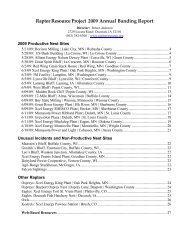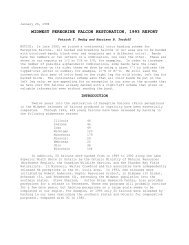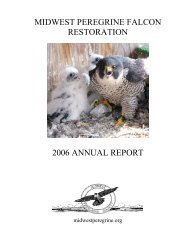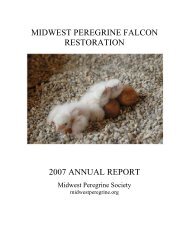2002 - Midwest Peregrine Falcon Restoration Project
2002 - Midwest Peregrine Falcon Restoration Project
2002 - Midwest Peregrine Falcon Restoration Project
Create successful ePaper yourself
Turn your PDF publications into a flip-book with our unique Google optimized e-Paper software.
42<br />
Each cooperating state or province has, in addition, its own list of cooperators.<br />
BREEDERS SUPPLYING PEREGRINES FOR <strong>2002</strong> RELEASES<br />
• Mark Bolton, Hugo, Minnesota (Kentucky releases)<br />
• Walter Crawford and Mike Cooke, World Bird Sanctuary, St. Louis, Missouri (St.<br />
Louis releases)<br />
• Bruce Haak (Iowa release)<br />
• Bill Murphy (Kentucky releases)<br />
READING BANDS WITH TELESCOPE AND DIGITAL CAMERA<br />
In <strong>2002</strong>, I (HBT) turned to digiscoping in hope of increasing my ability to read<br />
peregrine color bands in the field. Digiscoping is the ungainly word for taking digital<br />
photos through a telescope. There is a lot of technical information available on the Web<br />
about this topic and that is the place to start. Here, however, are some things I learned by<br />
experience this past season. My scope is a Leica Apo-Televid 77with an angular zoom<br />
20X-60X eyepiece, and my camera is a Nikon 5000 with the largest memory card I could<br />
get, 530 mb.<br />
I get best results with the camera at full optical zoom (3X) and the scope at<br />
30X to 50X.<br />
With luck, photos good enough to read bands can be taken of falcons up to<br />
400 feet away, maybe a bit farther with excellent light<br />
Use the steadiest tripod you can get and extend it no more than necessary.<br />
Motion is the constant enemy. Fast shutter speeds that might control motion<br />
are usually ruled out because the huge magnifications, often over 100X,<br />
demand too much light.<br />
Take as many shots as you think you need, then at least that many more.<br />
Often I would go home with 80 or 90 shots of a single bird and find that only<br />
on one or two could I see the band.<br />
<strong>Peregrine</strong>s often sit in one place for a long time. Even if the legs are not<br />
exposed, sooner or later the bird may stretch or preen and give you a look at<br />
the left leg. These events are not predictable, so take shot after shot, hoping to<br />
catch what you need. The one great advantage of digital photography is that<br />
the shots don’t cost anything, once you have the equipment.<br />
My Nikon camera has a bewildering array of options. For digiscoping, it<br />
seems to do best focussed at infinity with the shutter speed programmed by<br />
the camera. Some of the Web sites advise using the “point and shoot” option,<br />
letting the camera do the rest.<br />
Choose “normal” or “fine” for resolution. “Hi” is tempting, but the “.tif”<br />
images are painfully slow to download and to manipulate in a computer.<br />
Images in “basic’ do not hold together well when enlarged by the computer.








